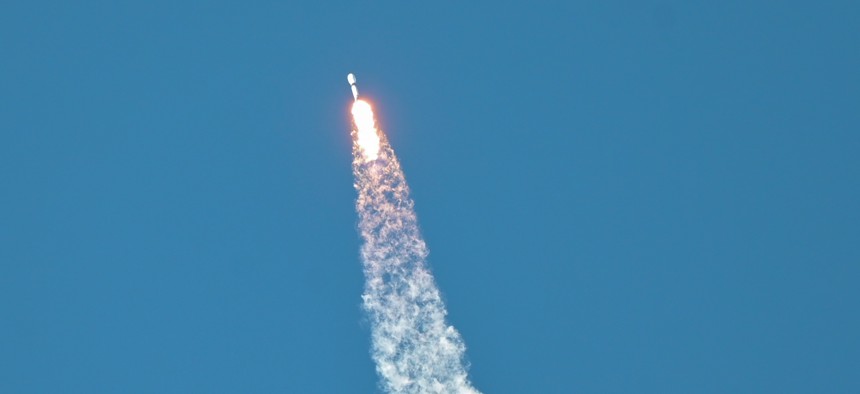
A SpaceX Falcon 9 launched the Space Development Agency’s first batch of satellites for its Tranche 0 mission to low-Earth orbit from Vandenberg Space Force Base, Calif., on April 2, 2023. U.S. Space Force / Senior Airman Rocio Romo
SDA readies second batch of satellites for its space data network
The Proliferated Warfighter Space Architecture was designed to be the “space backbone” for JADC2.
The Space Development Agency is gearing up to launch its next set of satellites as it works to build a future network of hundreds of military satellites and sensors.
On Thursday, SDA will launch its second batch of satellites into low-Earth orbit to test out concepts in space—called “Tranche 0.” This batch, which will be used just for demonstration purposes, will pave the way for Tranche 1 and 2, which in 2024 will begin delivering operational capabilities for warfighters.
“We're looking to show that you can build out sort of a proliferated architecture that allows you to do things like tactical data links, beyond-line-of-sight targeting, and advanced missile detection and tracking—so those are sort of the three core things that we're looking to demonstrate on Tranche 0,” Mike Eppolito, the Tranche 0 program director, told reporters Wednesday.
SDA, one of the Space Force’s acquisition arms, envisions its “Proliferated Warfighter Space Architecture” as a layered network of military satellites. It was designed to be the “space backbone” for the Pentagon’s Joint All Domain Command and Control concept, or JADC2, which aims to link every weapon, sensor, and system.
The first 10 Tranche 0 satellites were launched in April: eight built by York Space Systems and two by SpaceX.
“The one that we are launching tomorrow—there's 13 more that are going on orbit. So we have two SpaceX tracking satellites, one more York transport satellite, and then we have all 10 of the Lockheed Martin satellites that will be part of that launch,” Eppolito said.
The satellites will be launched via SpaceX’s Falcon 9 rocket from Vandenberg Space Force Base, California. SDA also has a third launch planned later this year in partnership with the Missile Defense Agency, Eppolito said.
Eppolito said he’s “incredibly happy” with the progress they’ve made with the first 10 Tranche 0 satellites currently on orbit.
However, SDA is still waiting for approval to broadcast the Pentagon’s Link 16 datalink from the Tranche 0 satellites. Link 16 is a special data link used to connect military hardware.
“The most notable milestone that we're looking to hit here near term is checking out the Link 16 payload. We have some outstanding policy issues that are holding that up, but from a technical standpoint, we've gotten through all the checkouts leading up until that policy hurdle and as soon as we get approval there, we plan to move forward with that checkout,” Eppolito said.
The agency expects they will obtain the waivers in the “near term” to demonstrate Link 16 on orbit, he said.
“Whenever you're demonstrating new technology, there's always going to be policy hurdles, I will tell you that. Part of SDA is demonstrating this new way of doing business is going to be dragging some of that policy along and making sure that we can get policy changes on a timely basis that satisfies the pace at which we're building these satellites,” he said.
The agency recently awarded Northrop Grumman and Lockheed Martin contracts to build satellites for Tranche 2, with combined contracts totaling $1.5 billion. The first Tranche 2 launch is scheduled for 2026.
“Now we’ve started building out Tranche 1 and procuring Tranche 2, so I think we've shown industry that they can count on SDA to continue procuring these satellites. They're able to invest in the components that are commodities at this point, and we'll get to that fully commoditized satellite that we're looking for,” he said.



